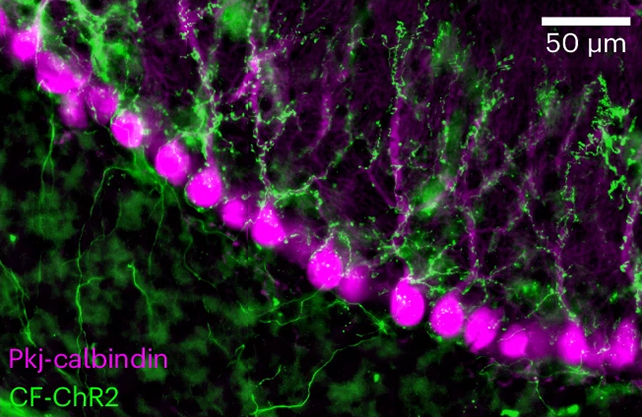ARTICLE AD
Scientists studying learning in mice have inadvertently encountered 'zombie neurons' in the brain – not flesh-eating, virus-spreading monsters, but cells that stop interacting normally even though they're functionally alive. What's more, they shed new light on learning processes in the brain.
A team from Portugal discovered the cells as part of an investigation into how a part of the brain called the cerebellum learns from the environment around us.
The cerebellum processes sensory information related to motor movements. It helps us walk down a crowded street, or pick up a drink without spilling it, and it's also important for learning: so if we bump into something, we know how to refine our movement to avoid it next time. Exactly how that learning happens was the subject of this new study.
Using optogenetics, where cells are manipulated by light, together with learning tasks carried out by mice, the researchers were able to show the key role of certain cerebellum inputs called climbing fibers.
"After we consistently stimulated climbing fibers during the presentation of a visual cue, the mice learned to blink in response to that cue – even in the absence of stimulation," says neuroscientist Tatiana Silva, from the Champalimaud Center for the Unknown.
"This proved that these fibers are sufficient to drive this type of associative learning."
 Brain imaging was used to detect neuron activity. (Silva et al., Nature Neuroscience, 2024)
Brain imaging was used to detect neuron activity. (Silva et al., Nature Neuroscience, 2024)It's long been thought that the climbing fibers were somehow involved in learning, and this is more evidence that might clarify some of the confusion and controversy surrounding their role. Other types of brain cells manipulated in the same way didn't have the same effect on the mice's ability to learn.
Then the researchers noticed the zombie neuron effect. The introduction of the light-sensitive protein Channelrhodopsin-2 (ChR2) as part of the optogenetics manipulation had essentially zombified climbing fiber cells.
That is to say, they were alive in the sense that they were still active and firing like neurons usually would – but those messages weren't being passed on. They had somehow become unplugged from other neural circuits, preventing the mice from being able to learn.
"It turned out that introducing ChR2 into the climbing fibers altered their natural properties, preventing them from responding appropriately to standard sensory stimuli like air puffs," says neuroscientist Megan Carey from the Champalimaud Center for the Unknown.
"This, in turn, completely blocked the animals' ability to learn."
We now have a much more precise idea of how learning works in the cerebellum. Given the similarities between mouse and human brains, it's reasonable to assume the same processes are at work.
The science of the brain, and everything it has to learn to do, continues to fascinate. It's even more impressive when you consider how it adapts and changes over time, and of course knowing more about it helps us protect it too.
"These results serve as the most compelling evidence to date that climbing fiber signals are essential for cerebellar associative learning," says Carey.
"Our next steps involve understanding why ChR2 expression leads to the 'zombification' of neurons and determining whether our findings extend to other forms of cerebellar learning."
The research has been published in Nature Neuroscience.

 9 months ago
44
9 months ago
44 

